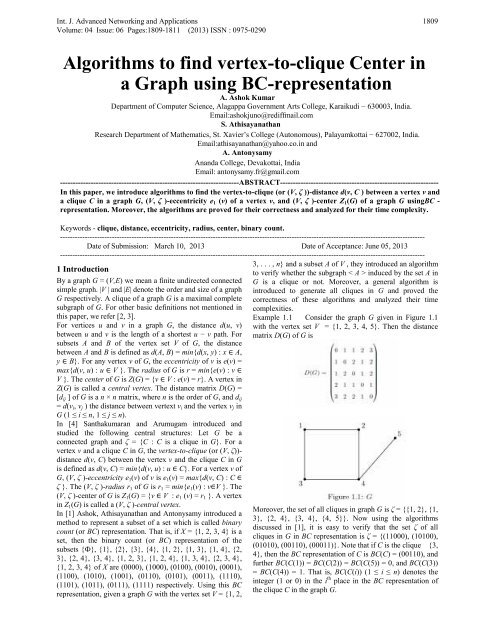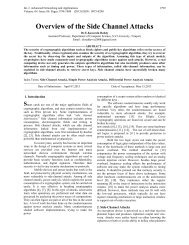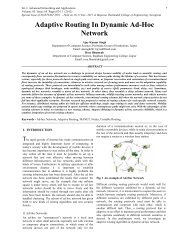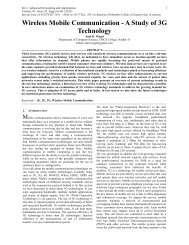Algorithms to find vertex-to-clique Center in a Graph using BC ... - ijana
Algorithms to find vertex-to-clique Center in a Graph using BC ... - ijana
Algorithms to find vertex-to-clique Center in a Graph using BC ... - ijana
You also want an ePaper? Increase the reach of your titles
YUMPU automatically turns print PDFs into web optimized ePapers that Google loves.
Int. J. Advanced Network<strong>in</strong>g and ApplicationsVolume: 04 Issue: 06 Pages:1809-1811 (2013) ISSN : 0975-02901809<strong>Algorithms</strong> <strong>to</strong> <strong>f<strong>in</strong>d</strong> <strong>vertex</strong>-<strong>to</strong>-<strong>clique</strong> <strong>Center</strong> <strong>in</strong>a <strong>Graph</strong> us<strong>in</strong>g <strong>BC</strong>-representationA. Ashok KumarDepartment of Computer Science, Alagappa Government Arts College, Karaikudi − 630003, India.Email:ashokjuno@rediffmail.comS. AthisayanathanResearch Department of Mathematics, St. Xavier’s College (Au<strong>to</strong>nomous), Palayamkottai − 627002, India.Email:athisayanathan@yahoo.co.<strong>in</strong> andA. An<strong>to</strong>nysamyAnanda College, Devakottai, IndiaEmail: an<strong>to</strong>nysamy.fr@gmail.com----------------------------------------------------------------------ABSTRACT--------------------------------------------------------------In this paper, we <strong>in</strong>troduce algorithms <strong>to</strong> <strong>f<strong>in</strong>d</strong> the <strong>vertex</strong>-<strong>to</strong>-<strong>clique</strong> (or (V, ζ ))-distance d(v, C ) between a <strong>vertex</strong> v anda <strong>clique</strong> C <strong>in</strong> a graph G, (V, ζ )-eccentricity e 1 (v) of a <strong>vertex</strong> v, and (V, ζ )-center Z 1 (G) of a graph G us<strong>in</strong>g<strong>BC</strong> -representation. Moreover, the algorithms are proved for their correctness and analyzed for their time complexity.Keywords - <strong>clique</strong>, distance, eccentricity, radius, center, b<strong>in</strong>ary count.----------------------------------------------------------------------------------------------------------------------------------------------------Date of Submission: March 10, 2013 Date of Acceptance: June 05, 2013----------------------------------------------------------------------------------------------------------------------------------------------------1 IntroductionBy a graph G = (V,E) we mean a f<strong>in</strong>ite undirected connectedsimple graph. |V | and |E| denote the order and size of a graphG respectively. A <strong>clique</strong> of a graph G is a maximal completesubgraph of G. For other basic def<strong>in</strong>itions not mentioned <strong>in</strong>this paper, we refer [2, 3].For vertices u and v <strong>in</strong> a graph G, the distance d(u, v)between u and v is the length of a shortest u − v path. Forsubsets A and B of the <strong>vertex</strong> set V of G, the distancebetween A and B is def<strong>in</strong>ed as d(A, B) = m<strong>in</strong>{d(x, y) : x ! A,y ! B}. For any <strong>vertex</strong> v of G, the eccentricity of v is e(v) =max{d(v, u) : u ! V }. The radius of G is r = m<strong>in</strong>{e(v) : v !V }. The center of G is Z(G) = {v ! V : e(v) = r}. A <strong>vertex</strong> <strong>in</strong>Z(G) is called a central <strong>vertex</strong>. The distance matrix D(G) =[d ij ] of G is a n × n matrix, where n is the order of G, and d ij= d(v i , v j ) the distance between <strong>vertex</strong>t v i and the <strong>vertex</strong> v j <strong>in</strong>G (1 ≤ i ≤ n, 1 ≤ j ≤ n).In [4] Santhakumaran and Arumugam <strong>in</strong>troduced andstudied the follow<strong>in</strong>g central structures: Let G be aconnected graph and ζ = {C : C is a <strong>clique</strong> <strong>in</strong> G}. For a<strong>vertex</strong> v and a <strong>clique</strong> C <strong>in</strong> G, the <strong>vertex</strong>-<strong>to</strong>-<strong>clique</strong> (or (V, ζ))-distance d(v, C) between the <strong>vertex</strong> v and the <strong>clique</strong> C <strong>in</strong> Gis def<strong>in</strong>ed as d(v, C) = m<strong>in</strong>{d(v, u) : u ! C}. For a <strong>vertex</strong> v ofG, (V, ζ )-eccentricity e 1 (v) of v is e 1 (v) = max{d(v, C) : C !ζ }. The (V, ζ )-radius r 1 of G is r 1 = m<strong>in</strong>{e 1 (v) : v!V }. The(V, ζ )-center of G is Z 1 (G) = {v ! V : e 1 (v) = r 1 }. A <strong>vertex</strong><strong>in</strong> Z 1 (G) is called a (V, ζ )-central <strong>vertex</strong>.In [1] Ashok, Athisayanathan and An<strong>to</strong>nysamy <strong>in</strong>troduced amethod <strong>to</strong> represent a subset of a set which is called b<strong>in</strong>arycount (or <strong>BC</strong>) representation. That is, if X = {1, 2, 3, 4} is aset, then the b<strong>in</strong>ary count (or <strong>BC</strong>) representation of thesubsets {Ф}, {1}, {2}, {3}, {4}, {1, 2}, {1, 3}, {1, 4}, {2,3}, {2, 4}, {3, 4}, {1, 2, 3}, {1, 2, 4}, {1, 3, 4}, {2, 3, 4},{1, 2, 3, 4} of X are (0000), (1000), (0100), (0010), (0001),(1100), (1010), (1001), (0110), (0101), (0011), (1110),(1101), (1011), (0111), (1111) respectively. Us<strong>in</strong>g this <strong>BC</strong>representation, given a graph G with the <strong>vertex</strong> set V = {1, 2,3, . . . , n} and a subset A of V , they <strong>in</strong>troduced an algorithm<strong>to</strong> verify whether the subgraph < A > <strong>in</strong>duced by the set A <strong>in</strong>G is a <strong>clique</strong> or not. Moreover, a general algorithm is<strong>in</strong>troduced <strong>to</strong> generate all <strong>clique</strong>s <strong>in</strong> G and proved thecorrectness of these algorithms and analyzed their timecomplexities.Example 1.1 Consider the graph G given <strong>in</strong> Figure 1.1with the <strong>vertex</strong> set V = {1, 2, 3, 4, 5}. Then the distancematrix D(G) of G isMoreover, the set of all <strong>clique</strong>s <strong>in</strong> graph G is ζ = {{1, 2}, {1,3}, {2, 4}, {3, 4}, {4, 5}}. Now us<strong>in</strong>g the algorithmsdiscussed <strong>in</strong> [1], it is easy <strong>to</strong> verify that the set ζ of all<strong>clique</strong>s <strong>in</strong> G <strong>in</strong> <strong>BC</strong> representation is ζ = {(11000), (10100),(01010), (00110), (00011)}. Note that if C is the <strong>clique</strong> {3,4}, then the <strong>BC</strong> representation of C is <strong>BC</strong>(C) = (00110), andfurther <strong>BC</strong>(C(1)) = <strong>BC</strong>(C(2)) = <strong>BC</strong>(C(5)) = 0, and <strong>BC</strong>(C(3))= <strong>BC</strong>(C(4)) = 1. That is, <strong>BC</strong>(C(i)) (1 ≤ i ≤ n) denotes the<strong>in</strong>teger (1 or 0) <strong>in</strong> the i th place <strong>in</strong> the <strong>BC</strong> representation ofthe <strong>clique</strong> C <strong>in</strong> the graph G.
Int. J. Advanced Network<strong>in</strong>g and ApplicationsVolume: 04 Issue: 06 Pages:1809-1811 (2013) ISSN : 0975-02901810In this paper we <strong>in</strong>troduce algorithms <strong>to</strong> <strong>f<strong>in</strong>d</strong> (V, ζ)-distance,(V, ζ)-eccentricity and (V, ζ)-center <strong>in</strong> a connected graph Gof order n(> 1) us<strong>in</strong>g <strong>BC</strong> representation.2 Vertex-<strong>to</strong>-Clique <strong>Center</strong> <strong>Algorithms</strong>First, we <strong>in</strong>troduce an algorithm <strong>to</strong> <strong>f<strong>in</strong>d</strong> the (V, ζ )-distanced(i, C) between a <strong>vertex</strong> i and a <strong>clique</strong> C <strong>in</strong> a graph G us<strong>in</strong>g<strong>BC</strong> representation.Algorithm 2.1 Let G be a graph with V = {1, 2, 3, . . . , n}and ζ = {C : C is a <strong>clique</strong> <strong>in</strong> <strong>BC</strong> representation <strong>in</strong> G}.1. Let D(G) = [d ij ] be the distance matrix of graph G.2. Let i ! V and C ! ζ .3. if <strong>BC</strong>(C(i)) = 1 then d(i, C) = 0, go<strong>to</strong> step 94. for j = 1 <strong>to</strong> n5. d(i, j) = n6. if <strong>BC</strong>(C(j)) = 1 then d(i, j) = d ij7. next j8. F<strong>in</strong>d d(i, C) = m<strong>in</strong>{d(i, j) : 1 ≤ j ≤ n}9. return d(i, C)10. s<strong>to</strong>pTheorem 2.2 For any <strong>vertex</strong> i and a <strong>clique</strong> C <strong>in</strong> a graph G,the Algorithm 2.1 <strong>f<strong>in</strong>d</strong>s the (V, ζ )-distance d(i, C) from the<strong>vertex</strong> i <strong>to</strong> the <strong>clique</strong> C.Proof. Let G be a graph with V = {1, 2, 3, . . . , n} , ζ = {C :C is a <strong>clique</strong> <strong>in</strong> <strong>BC</strong> representation <strong>in</strong> G}, and D(G) thedistance matrix of G. Let i ! V and C ! ζ . If the <strong>vertex</strong> i is a<strong>vertex</strong> of the <strong>clique</strong> C, then <strong>BC</strong>(C(i)) = 1 so that the (V, ζ)-distance d(i, C) = 0. If the <strong>vertex</strong> i is not a <strong>vertex</strong> of the<strong>clique</strong> C, then <strong>BC</strong>(C(i)) = 0, then the steps 4 <strong>to</strong> 6 of theAlgorithm 2.1 <strong>f<strong>in</strong>d</strong> the distance d(i, j) from the <strong>vertex</strong> i <strong>to</strong> thevertices j(1 ≤ j ≤ n) of G as follows: If j is a <strong>vertex</strong> of the<strong>clique</strong> C then <strong>BC</strong>(C(j)) = 1 otherwise <strong>BC</strong>(C(j)) = 0. Henced(i, j) = n if <strong>BC</strong>(C(j)) = 0 and d(i, j) = d ij if <strong>BC</strong>(C(j)) = 1(1 ≤j ≤ n). Then the step 8 of Algorithm 2.1 <strong>f<strong>in</strong>d</strong>s the (V, ζ )-distance d(i, C) = m<strong>in</strong>{d(i, j) : 1 ≤ j ≤ n} from the <strong>vertex</strong> i <strong>to</strong>the <strong>clique</strong> C.Theorem 2.3 The distance between <strong>vertex</strong> i and a <strong>clique</strong> C<strong>in</strong> a graph G can be found <strong>in</strong> O(n) time us<strong>in</strong>g Algorithm2.1.Proof. It follows from the fact that the step 3 is executed <strong>in</strong>O(1) time, the steps 4 <strong>to</strong> 7 are executed <strong>in</strong> O(n) time andstep 8 is executed <strong>in</strong> O(n) time <strong>in</strong> the Algorithm 2.1.Example 2.4 Consider the graph G of order n(= 5) given <strong>in</strong>Figure 1.1 and the distance matrix D(G) of G as <strong>in</strong> theExample 1.1. Now us<strong>in</strong>g the Algorithm 2.1, let us <strong>f<strong>in</strong>d</strong> the(V, ζ )-distance between the <strong>vertex</strong> i = 1 and the <strong>clique</strong> C= {1, 2}. Clearly <strong>BC</strong>(C) = (11000). S<strong>in</strong>ce <strong>BC</strong>(C(i)) = 1, theAlgorithm 2.1 returns (V, ζ )-distance d(i, C) = 0. Aga<strong>in</strong>us<strong>in</strong>g the Algorithm 2.1, let us <strong>f<strong>in</strong>d</strong> the (V, ζ )-distance d(i,C) between the <strong>vertex</strong> i = 1 and the <strong>clique</strong> C = {2, 4}.Clearly <strong>BC</strong>(C) = (01010). S<strong>in</strong>ce <strong>BC</strong>(C(i)) = 0, the Algorithm2.1 <strong>f<strong>in</strong>d</strong>s the (V, ζ )-distance d(i, C) = m<strong>in</strong>{d(i, j) : 1 ≤ j ≤n}. S<strong>in</strong>ce <strong>BC</strong>(C(j)) = 0, d(i, j) = n for j = 1, 3, 5 and s<strong>in</strong>ce<strong>BC</strong>(C(j)) = 1, for j = 2, 4, d(i, 2) = d i2 = 1 and d(i, 4) = d i4 =2. Hence the algorithm 2.1 returns (V, ζ )-distance d(i, C) =m<strong>in</strong>{d(i, j) : 1 ≤ j ≤ n} = m<strong>in</strong>{d(1, 1), d(1, 2), d(1, 3), d(1,4), d(1, 5)} = m<strong>in</strong>{5, 1, 5, 2, 5} = 1.Next, we <strong>in</strong>troduce an algorithm <strong>to</strong> <strong>f<strong>in</strong>d</strong> the (V, ζ )-eccentricity e 1 (i) of a <strong>vertex</strong> i <strong>in</strong> a graph G of order n us<strong>in</strong>g<strong>BC</strong> representation.Algorithm 2.5 Let G be a graph with V = {1, 2, 3, . . . , n}and ζ = {C : C is a <strong>clique</strong> <strong>in</strong> <strong>BC</strong> representation <strong>in</strong> G}.1. Let ζ = {C 1 , C 2 , . . . , C m }.2. Let i ! V3. for j = 1 <strong>to</strong> m4. F<strong>in</strong>d d(i, C j ) , by call<strong>in</strong>g Algorithm 2.15. next j6. <strong>f<strong>in</strong>d</strong> e 1 (i) = max{d(i, C j ) : 1 ≤ j ≤ m}7. return e 1 (i)8. s<strong>to</strong>pTheorem 2.6 For a <strong>vertex</strong> i and the set of all <strong>clique</strong>s ζ <strong>in</strong> G,the Algorithm 2.5 <strong>f<strong>in</strong>d</strong>s (V, ζ )-eccentricity e 1 (i).Proof. Let G be a graph with V = {1, 2, 3, . . . , n} and ζ= {C 1 , C 2 , . . . , C m } be the set of all <strong>clique</strong>s <strong>in</strong> <strong>BC</strong>representation <strong>in</strong> G. Let i ! V . Then the step 4 of Algorithm2.5 <strong>f<strong>in</strong>d</strong>s the (V, ζ )-distance d(i, C j ) between the <strong>vertex</strong> i andevery <strong>clique</strong> C j (1 ≤ j ≤ m) <strong>in</strong> G, and the step 6 of Algorithm2.5 <strong>f<strong>in</strong>d</strong>s (V, ζ )-eccentricity e 1 (i) = max{d(i, C j ) : 1 ≤ j ≤m}. Hence the theorem.Theorem 2.7 The Algorithm 2.5 <strong>f<strong>in</strong>d</strong>s (V, ζ )-eccentricitye 1 (i) of <strong>vertex</strong> i <strong>in</strong> a graph G <strong>in</strong> O(mn) time.Proof. By Theorem 2.3, the time complexity of the step 4 <strong>in</strong>the Algorithm 2.5 is O(n), so that the steps 3 <strong>to</strong> 5 <strong>in</strong> theAlgorithm 2.5 are executed <strong>in</strong> O(mn) time. The timecomplexity of the step 6 <strong>in</strong> the Algorithm 2.5 is O(m). Hencethe theorem.Example 2.8 Consider the graph G given <strong>in</strong> Figure 1.1with the <strong>vertex</strong> set V and the <strong>clique</strong> set ζ as <strong>in</strong> the Example1.1. Clearly the order n of G is 5 and the number of <strong>clique</strong>sm <strong>in</strong> G is 5. Let C 1 = (11000), C 2 = (10100), C 3 = (01010),C 4 = (00110), C 5 = (00011), and i = 1 ∈ V . Now we <strong>f<strong>in</strong>d</strong> the(V, ζ )-eccentricity e 1 (i). By call<strong>in</strong>g the Algorithm 2.1 mtimes, the step 4 of Algorithm 2.5 <strong>f<strong>in</strong>d</strong>s the (V, ζ )-distancesd(i, C 1 ) = 0, d(i, C 2 ) = 0, d(i, C 3 ) = 1, d(i, C 4 ) = 1 and d(i,C 5 ) = 2. Then the step 6 of Algorithm 2.5 <strong>f<strong>in</strong>d</strong>s the (V, ζ )-eccentricity e 1 (i) = max{0, 0, 1, 1, 2} = 2.F<strong>in</strong>ally, we <strong>in</strong>troduce an algorithm <strong>to</strong> <strong>f<strong>in</strong>d</strong> the (V, ζ )-centerZ 1 (G) of a graph G of order n us<strong>in</strong>g <strong>BC</strong> representation.Algorithm 2.9 Let G be a graph with V = {1, 2, 3, . . . , n}and ζ = {C : C is a <strong>clique</strong> <strong>in</strong> <strong>BC</strong> representation <strong>in</strong> G}.1. Let ζ = {C 1 , C 2 , . . . , C m }
Int. J. Advanced Network<strong>in</strong>g and ApplicationsVolume: 04 Issue: 06 Pages:1809-1811 (2013) ISSN : 0975-029018112. Let Z 1 (G) = Ф.3. for i = 1 <strong>to</strong> n4. F<strong>in</strong>d e 1 (i), by call<strong>in</strong>g Algorithm 2.5.5. next i6. F<strong>in</strong>d r 1 = m<strong>in</strong>{e 1 (i) : 1 ≤ i ≤ n}7. for i = 1 <strong>to</strong> n8. if e 1 (i) = r 1 then Z 1 (G) = Z 1 (G) U {i}.9. next i10. S<strong>to</strong>pTheorem 2.10 For a graph G, the Algorithm 2.9 <strong>f<strong>in</strong>d</strong>s (V,ζ )-center Z 1 (G) of G.Proof. Let G be a graph with V = {1, 2, . . . , n} and ζ= {C 1 , C 2 , . . . , C m } be the set of all <strong>clique</strong>s <strong>in</strong> their <strong>BC</strong>representation <strong>in</strong> G. The step 4 of Algorithm 2.9, <strong>f<strong>in</strong>d</strong>s (V,ζ )-eccentricity e 1 (i) for all i ∈ V (1 ≤ i ≤ n). Then the step 6<strong>f<strong>in</strong>d</strong>s (V, ζ )-radius r 1 = m<strong>in</strong>{e 1 (i) : i ∈ V } of G, and thesteps 7 <strong>to</strong> 9 <strong>f<strong>in</strong>d</strong> (V, ζ )-center Z 1 (G) = {i ∈V : e 1 (i) = r 1 }.Thus the Algorithm 2.9 <strong>f<strong>in</strong>d</strong>s (V, ζ )-center Z 1 (G) of G.Theorem 2.11 The (V, ζ )-center Z 1 (G) of a graph G can beobta<strong>in</strong>ed <strong>in</strong> O(mn 2 ) time us<strong>in</strong>g Algorithm 2.9.Proof. By Theorem 2.7, the comput<strong>in</strong>g time for step 4 of theAlgorithm 2.9 is O(mn) so that time complexity for the steps3 <strong>to</strong> 5 of the Algorithm 2.9 is O(mn 2 ). The step 6 of theAlgorithm 2.9 <strong>f<strong>in</strong>d</strong>s r 1 <strong>in</strong> O(n) time and the steps 7 <strong>to</strong> 9 ofthe Algorithm 2.9 <strong>f<strong>in</strong>d</strong>s Z 1 (G) of G <strong>in</strong> O(n) time. Hence thetheorem.Example 2.12 Consider the graph G given <strong>in</strong> Figure 1.1 as<strong>in</strong> the Example 1.1. Clearly the <strong>vertex</strong> set of G is V = {1, 2,3, 4, 5} and the set of all <strong>clique</strong>s <strong>in</strong> G is ζ = {(11000),(10100), (01010), (00110), (00011)}. Now we <strong>f<strong>in</strong>d</strong> the (V,ζ )-center Z 1 (G). By call<strong>in</strong>g the Algorithm 2.5 n times, thestep 4 of Algorithm 2.9 <strong>f<strong>in</strong>d</strong>s the (V, ζ )-eccentricities e 1 (1)= 2, e 1 (2) = 1, e 1 (3) = 1, e 1 (4) = 1, and e 1 (5) = 2. The step 6of Algorithm 2.9 <strong>f<strong>in</strong>d</strong>s the (V, ζ )-radius r 1 = m<strong>in</strong>{e 1 (i) : 1 ≤ i≤ n} = 1. F<strong>in</strong>ally, the step 8 of Algorithm 2.9 <strong>f<strong>in</strong>d</strong>s the (V, ζ)-center Z 1 (G) = {i ∈ V : e 1 (i) = r 1 } = {2, 3, 4}.3 ConclusionIn this paper we have developed sequential algorithms <strong>to</strong><strong>f<strong>in</strong>d</strong> the (V, ζ )- central structures <strong>in</strong> a graph G and thesealgorithms may be used <strong>in</strong> network<strong>in</strong>g, data m<strong>in</strong><strong>in</strong>g andcluster analysis.[3] K.R.Parthasarathy, Basic <strong>Graph</strong> Theory, TataMcGraw-Hill Publish<strong>in</strong>g Company Limited, NewDelhi(1994).[4] A.P.Santhakumaran and S.Arumugam, centralitywith Respect <strong>to</strong> Cliques, International Journal ofManagement and Systems, 18, No.3(2002), 275-280Authors BiobraphyDr.A.Ashok Kumar – He was awardedPh.D. <strong>in</strong> computer Science byManonmaniam sundaranar university,Tirunelveli, Tamil Nadu, India. Heauthored three books <strong>in</strong> computerscience. Now he is work<strong>in</strong>g as AssistantProfessor <strong>in</strong> computer science at Alagappa Govt ArtsCollege, Karaikudi, Tamilnadu. His area of research<strong>in</strong>terests <strong>in</strong>cludes <strong>Algorithms</strong>, Networks and Distributedsystems.Dr.S.Athisayanathan – He was awardedPh.D. <strong>in</strong> Mathematics by Manonmaniamsundaranar university, Tirunelveli, TamilNadu, India. He is work<strong>in</strong>g as Professorand Head <strong>in</strong> Research department ofmathematics at St.Xavier’sCollege(Au<strong>to</strong>nomous), Palayamkottai,TamilNadu. His area of <strong>in</strong>terest <strong>in</strong>cludes De<strong>to</strong>ur concepts <strong>in</strong>graphs and related <strong>Graph</strong> theory areas..Rev.Dr.A.An<strong>to</strong>nysamy – He wasawarded Ph.D. <strong>in</strong> computer science byMadurai Kamaraj University,TamilNadu. He has more than 35 yearsof experience <strong>in</strong> teach<strong>in</strong>g and research.He is work<strong>in</strong>g as Pr<strong>in</strong>cipal, AnandaCollege, Devakottai, Tamilnadu. Hisarea of <strong>in</strong>terest <strong>in</strong>clude <strong>Graph</strong> theoryand Computer <strong>Algorithms</strong>.References[1] A.Ashok Kumar, S.Athisayanathan, A.An<strong>to</strong>nysamy,Algorithm <strong>to</strong> F<strong>in</strong>d All Cliques <strong>in</strong> a <strong>Graph</strong>, InternationalJournal of Advanced Network<strong>in</strong>g and Applications, Vol.2, No-2(2010), 597-601.[2] G. Chartrand and Ortrud R. Oellermann, Applied andAlgorithmic <strong>Graph</strong> Theory, McGraw-Hill Internationaleditions (1993).





